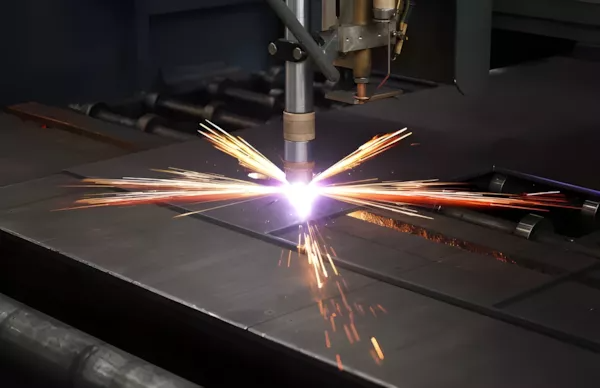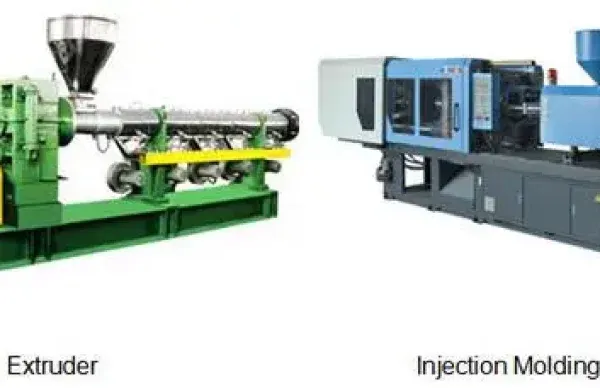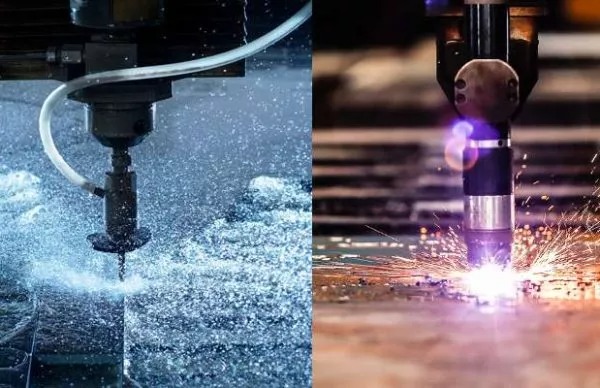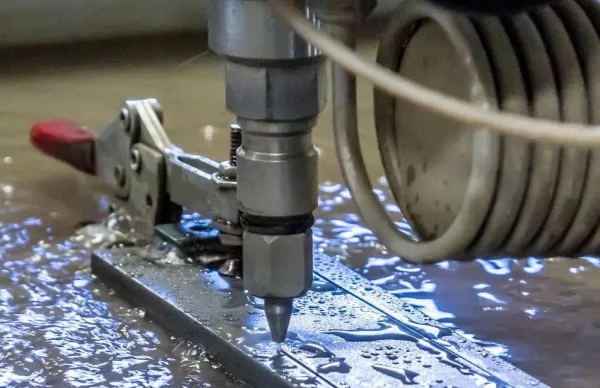Although both plasma and laser involve heat to cut (or shape) the metal, deciding on laser cutting vs plasma cutting in fabrication projects is an analytic task. These thermal cutting methods have distinct capabilities and machining preferences. The right choice depends on which method can meet your cutting requirements, including material compatibility, desired accuracy, speed, and budget constrain.
This article will present a comparative overview of plasma and laser cutting methods, including their advantages, disadvantages, and head-to-head comparison to ease your decision-making.
What’s Laser Cutting?
Laser cutting is a non-contact cutting process that cuts through various material sheets. A concentrated laser beam precisely melts and vaporizes the material to make complex contour cuts. The history of laser-cutting machines can be traced back to 1964 when an industrial company used it to drill the die tooling for the first time.

Over time, laser cutting machines have continuously evolved, and advanced CNC laser cutters are what we have today. The CNC integration allows to movement of the laser head accurately through G and M Codes, with tolerances as low as ±0.003 mm.
How Laser Cutting Works?
A complicated laser system with multiple components executes the laser-cutting process, which involves everything from creating the laser to controlling the beam into a predefined cutting path.

The process starts with laser generation, where an electric supply (spark) accelerates the atoms on a lasing medium such as CO₂ and fiber optics. This phenomenon generates a highly concentrated beam that is amplified and directed toward the cutting area using mirrors. Then, the series of focusing lenses converges the light to an intense point, increasing the energy density as it passes through the nozzle.
Furthermore, a laser cutting torch or focusing head allows for the movement of the nozzle head, controlled by CNC programs into a predetermined path. The focused laser causes the localized heating and melts the material, whereas a gas stream blows the eroded material away.
Types of Laser Cutters
In manufacturing, mainly three types of laser-based cutters are in practice, each defined by the medium used to produce the laser beam; CO₂, fiber optics, and Nd: YAG crystal. These lasing mediums have distinct wavelengths of 10.6 µm, 1.06 µm, and 1.06 µm respectively. The wavelength variation influences how well the laser interacts with various materials. For instance, some Materials absorb certain wavelengths better than others.
- CO₂ Laser Cutter: It uses CO₂ gas mixture to produce the concentrated beam of laser, particularly used for non-metallic sheets like thermoplastic and wood.
- Fiber Laser Cutter: A fiber optic cable amplifies the light and produces the laser. It cuts best with metallic worksheets.
- Nd: YAG: Crystals of Neodymium-Doped Yttrium Aluminum Garnet are used as a lasing medium for these types of lasers.
What’s Plasma Cutting?
Plasma cutting is the process of splitting metallic sheets with a hot stream of ionized gases. An electric spark provides intense heat to compressed gases (air, hydrogen, or argon) that excites atoms for movement. Then, the continuous collision of molecules causes their separation from gases, called plasma which is more than 20000 °C.

In the industrial setup, a CNC plasma cutting machine guides the stream of plasma to make intricate cuts, which heats, melts, and erodes the material precisely. You can cut metals as thick as 1.5 inches, higher in the context of plasma vs laser cutter.
How Plasma Cutting Works?

Plasma torches are the key device for this process. It consists of multiple components, including an electrode, gas supply, nozzle, and shield gas. The electrode sparks an electric arc in compressed gas (air or inert gases), then the nozzle directs the formed plasma jet toward the workpiece.
As the plasma jet interacts with the work surface, it causes localized heating and melts the material. Meanwhile, the high-velocity jet also sweeps away the molten material from the cut.
Types of Plasma Cutters
The plasma cutting systems can have different types of cutters to work on the table. Air, oxygen, HD, and CNC plasma cutters are some common examples.
- Air plasma cutter: It involves air as a lasing medium, best for small-sized parts or low-volume runs.
- Oxygen Plasma Cutter: The plasma from the ionization of oxygen molecules provides much more precision and complex cut capabilities than air.
- CNC Plasma Cutter: The CNC control of the striking path allows for accurate and consistent cuts. Most of the industries use this type of automatic plasma cutter for high-quality results.
Key Differences Between Laser Cutting and Plasma Cutting
The key aspects to discuss the differences between laser cutting vs plasma cutting are the power source, material compatibility, speed, thickness, and expenses.
Cutting Precision and Accuracy
Accuracy is one of the main difference between laser cutting and plasma cutting. Laser is more concentrated than the plasma stream, which allows for accurate positioning in narrow areas. It can cut consistent contours with tight tolerances, clean edges no burrs. On the other hand, plasma is less accurate and also produces more kerf. You can achieve the tolerances down to ±0.030 mm with the laser cutting, whereas it is ± 0.1mm for plasma cuts.
Speed and Efficiency
The cutting speed comparison of plasma vs laser cutter depends on the thickness. Laser is almost two times faster than plasma for thinner sheets ( < 1.25mm), whereas plasma excels in cutting thicker sheets. Subsequently, the speed also varies depending on source power and the type of material being cut. For instance, a 200 W laser can cut 3 mm thick mild steel with up to 10m/ min of speed.
Furthermore, laser machines are energy efficient, and consume less energy than creating plasma.
Materials
The laser cutting systems are compatible with diverse material types, including steel, aluminum, copper, acrylic, thermosets, rubbers, and wood. In contrast, plasma works only with conductive metals. The plasma arc needs a circuit to flow through, which is completed when the conductive material acts as the “ground” in the electrical circuit.
Although laser has a wide material option, some possess the risk of operational and environmental hazards. For instance, PVC produces toxic fumes. Additionally, which type of laser you are using also affects the material’s compatibility.
Surface Finish
The laser cut metal surfaces are smooth and burr-free, even for the narrow cuts and intricate designs. The edges are also sharp and clean. So, no or minimal post-processing requirements for the cut. On the other hand, plasma leaves slag and rougher edges with burrs, which demand grinding, bead blasting, and other post-processing actions.
Furthermore, the material type, thickness, and laser type influence the exact roughness value (Ra), typically 0.8 to 6 µm. The plasma may produce cuts with a better surface finish than fiber laser in some cases.
Cost and Operational Expenses
CNC plasma cutters are cost-effective for installation, and they cost $10,000 to $100,000. In contrast, the complex setup and advanced equipment for lasers make them expensive, $50,000 to $500,000. Subsequently, the operating costs are also slightly higher for laser systems than for plasma.
“The overall cost of Laser cutting or plasma cutting for your project depends on design complexity, desired precision, and market competitiveness. In China, it is $15–$20/hour, significantly lower than in the US & Europe”
Cutting Thickness
If we compare Laser cutting vs plasma cutting thickness capabilities, the plasma jet is highly effective for thicker material, up to 50 mm. On the other hand, the laser is limited to 25mm. Moreover, the thickness also depends on which material you are cutting.
Applications
Plasma cutting is popular in heavy industries like shipbuilding and construction for speed and thickness. For example, structural beams, boat parts, agricultural machinery, Oil & gas components, etc.
Laser cutting has extensive use in precision-demanding fields like electronics, aerospace, automotive, and jewelry For example, micro-components in chips, car body panels, aircraft airframes, etc.






